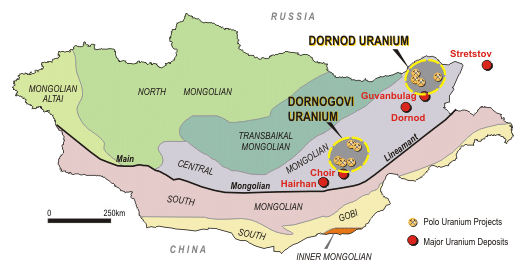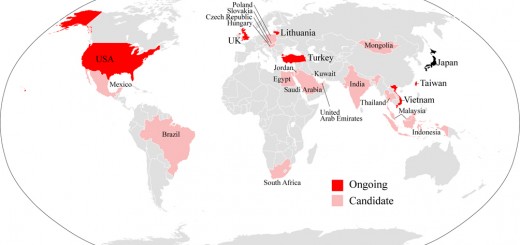The Uranium Extraction Policy of Mongolia: The Current Situation Nuke Info Tokyo No. 163
SELENGE Lkhagvajav
Head of the national movement “For a Nuclear Safe Mongolia”
Mongolia is located between Russia and China, two large powers. The territory of Mongolia is 1.5 million km2 and is populated by 2.9 million inhabitants. Mongolia possesses tremendous mineral resources.
There are approximately 1170 deposits of a total of 80 types of minerals registered in Mongolia. The mineral resources of the country are estimated by international economists to be worth USD1.3 trillion. Coal deposits alone are estimated to be 175 billion tons, which ranks Mongolia 15th in the world for coal resources. In addition, there are rich deposits of gold and silver, ores of the elements copper, iron, phosphorus, zinc, and uranium, as well as schist. Minerals make up 94 percent of the total exports of Mongolia.

2. Uranium resources of Mongolia
The uranium deposits are generally concentrated in the east of the country (see map below). Currently, 70 percent of the entire territory of Mongolia has been explored for uranium. Preliminary estimates suggest that Mongolia holds 1.5 million tons of uranium resources, which would rank as the 10th largest uranium resources in the world.
3. Policy of the government of Mongolia on uranium extraction
The Mongolian parliament approved the Law on Nuclear Energy, which governs uranium extraction and utilization of nuclear energy, on 16th July 2009. The adoption of this law legally guaranteed the extraction of uranium and the nuclear energy policy.
The government, named the “Democratic Renovation Government” was established in 2012, and included the extraction of uranium together with the production and export of uranium trioxide in its action plan for 2012-2016.
4. Licensing
According to recent information, 13 foreign-based companies, such as those in France, the Netherlands, UK, the Virgin Islands, the People’s Republic of China, US, Canada, the Russia Federation and Japan hold 58 special licenses for the mining of radioactive minerals in Mongolia. The largest number, 25 special licenses, is held by the Areva Company of France.
5. Foreign companies implementing projects with a view to uranium extraction
Uranium extraction is not new to Mongolia. In 1988-1995, during the socialist period, the Soviets extracted uranium from an underground mine at the Mardai deposit in eastern Mongolia. Although the Soviets have left the area, high levels of radiation are still being emitted from the abandoned mine tailings (see figure).
NGOs have established that the radiation level in the area is 50 times the normal level. The local inhabitants pick up construction materials from the ruins of the apartment blocks in the high radiation area, where Soviet personnel used to live, to use in the construction of houses and even a kindergarten. However, there are still no experts or laboratories in the area to take regular measurements of the radiation level around the abandoned mine or investigate the health impacts on the local community.
Currently, Russian, Chinese, US and French government-owned companies have been working to implement projects in Mongolia. Of these, the French Areva Group is now ready to commence extraction.
The Areva Group first arrived in Mongolia in 1996. As mentioned above, it holds the largest number of licenses. The total area under their licenses is 9,124 km2. Areva extracted uranium in Nigeria for 50 years, ceasing in October 2013. In exactly that same month, In October 2013, the French Foreign Affairs minister paid an official visit to Mongolia. France, Mongolia and Japan concluded a share-holding agreement and the preparations for uranium extraction got underway.
6. Public awareness on uranium.
For the extraction of uranium in Mongolia, Areva is using deep ground soaking technology. While described as the most reliable, this technology has shown itself to be unsuitable to the conditions of Mongolia. The Mongolians are nomadic pastoralists. In the areas where uranium is extracted under the Areva technology, a massive drop in the numbers of livestock, with changes in livestock liver, lungs and other internal organs, is experienced together with generally defective young animals born and the local population suffering health impacts. These phenomena were never experienced before.
The government of Mongolia had so-called professional organizations conduct tests in those areas, but these have failed to establish the exact cause of the incidents. The specimens were then sent abroad for laboratory testing, but the results are still being awaited two years later. The Prime Minister reported to the public that a substance called selenium1) caused the incidents. However, he has no information about where the selenium emerged from to damage the health of animals and humans, and is seemingly unwilling to report on this even if the information is available. The Department for Nuclear Energy also fails to give correct explanations. According to his university major, the Prime Minister is a schoolteacher of physics, as is the Director of the Department for Nuclear Energy.
7. Civil society organizations
There is another issue, which may now seem to be obsolete, but which has metamorphosed and is hiding in a dormant phase. The foreign press and media published information in 2011 that the government of Mongolia had agreed to receive nuclear waste from foreign powers for burial in the Gobi zone, in the South of Mongolia, intriguing the passions of all powers that exploit nuclear energy.
In the first plan, the nuclear waste from nuclear power stations in Japan, Korea, and Taiwan was to be received, and then the issue of burying nuclear waste in the Mongolian Gobi was to be considered.
As soon as this information leaked, the Mongolian Green Party expressed strong opposition and the media publicized our protests daily. The result was that the Mongolian public became comparatively well aware of what nuclear waste is and of its harmful effects, leading to civil society organizations and individuals joining the protests. All these resulted in a Decree of the President of Mongolia, which was sufficient to calm the anger that had been inflamed by the issue.
Our politicians are sly, the President is one of them and might be the most devious of all. That is because he is in his second term of presidency. Within a week, the President reported to the UN General Assembly session that he had issued the decree. This raised the President’s popularity both overseas and at home.
Nonetheless, intense activity has been taking place regarding the uranium extraction and nuclear power policies of the government. Another ironic point is that the President, Prime Minister and 90 percent of the MPs think that foreign nuclear waste is harmful, but that the nuclear waste that results when Mongolia begins to produce nuclear energy will be harmless, that there is no harm in uranium extraction, and even that it is permissible to contaminate some portion of the territory with radiation, because Mongolia has a vast territory anyway.
8. The attitude of the press and media on the uranium issue
According to the latest data, there are 166 TV stations, 84 radio stations, and 135 newspapers active in Mongolia. (This must wrong; there are only three million of us. If it is true, then Mongolia is undergoing a media boom along with the mining boom. Is this a good sign or an evil sign?)
At the beginning of the nuclear waste scandal mentioned above, the press and media reported our meetings and statements daily. However, the situation is quite the opposite now. All the numerous TV stations except one are private. The closet owners of these countless media outlets are the oligarchs. (Because of the small size of the population, we know very well which oligarch is the owner of which TV station.)
In the beginning, they would naively transmit what we said. However, because a lot of money is considered to be behind the uranium issue, their tactics have become more refined. The Department for Nuclear Energy spent a huge amount of the public budget on transporting journalists to resorts where they were brainwashed under the pretext of training, even to the extent of taking them to France and Kazakhstan. Those journalists would then praise uranium extraction and atomic energy until their throats became sore.
They also never forget to blame civil society organizations. They call us racketeers; accusing us of accepting bribes from foreign institutions. They also describe us as non-professionals without literacy on the uranium issue, not even knowing a single physics equation. (Maybe radiation will disappear if we learn equations by heart?)
There is another innovation in the Mongolian press and media. This is called the “agreement of closure.” We have no idea whether such agreements are practiced in other countries. In Mongolia, large-scale companies pay huge amounts of money to TV stations, radio stations, and websites not to publish any negative information about them. If money was given directly it would be identified as corruption, so the contract is concluded for one year and named an “agreement of closure.”
The Department of Nuclear Energy aims to get the public used to the terminology of “nuclear technology” by publishing daily news items in the press and media about “… the installation of radiation therapy equipment at the cancer hospital, application of nuclear technology for the improvement of livestock health” and, even further, “because nuclear reactions are constantly underway in the sun, we are always naturally exposed to radiation in the environment. Thus we shouldn’t be wary of radiation; having a uranium mine is the dream of all nations. Therefore, we are lucky to have uranium so that we have the opportunity to have the mine make our dream come true,” as the Director of the Department of Nuclear Energy says. Thus, the issue of uranium extraction in Mongolia is progressing under a strategy of brainwashing.
This is the actual situation in Mongolia as the country prepares for uranium extraction.
1) Selenium is a trace element required by living organisms, but compared with other elements it has the characteristic that the concentration at which it becomes toxic and the concentration at which it becomes deficient are extremely close. Excessive intake can lead to severe gastrointestinal distress, nervous disorders, respiratory insufficiency syndrome, cardiac infarction, and renal failure.


